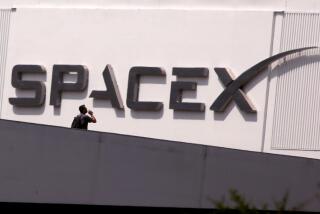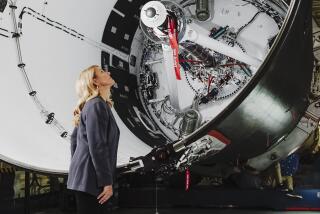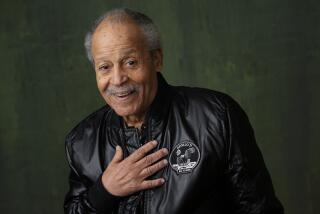Rocketdyne Machinists Celebrate 30th Anniversary : Backstage Heroes of Space Age Show Their Metal
Astronaut Joe Engle was out in the back, autographing pictures for the crowd gathered around the Apollo 14 spacecraft and a golf cart-sized lunar exploration craft.
But the real heroes of outer space were indoors Saturday when Rocketdyne opened its Canoga Park rocket-engine factory to about 25,000 people to celebrate its 30 years in business.
Clint Daniel was in the plant’s machine shop, explaining to his family how he uses a 15-foot-tall vertical turret lathe to help grind parts for the space shuttle’s fuel pump.
Down the hall, Abdul Muhammad was standing next a five-ton jig-bore machine, telling his wife how he drills precision weld holes that hold the engines together.
The two are among more than 425 workers who have been with Rockwell International since 1955, when the company’s Rocketdyne division plant launched America’s space program from a Warner Ranch pasture.
Since then, thousands of rocket engines have rolled out of the 56-acre Canoga Avenue factory and roared into space.
“I never get tired of seeing them go up,” said Daniel, 53, of Redondo Beach. “It’s just amazing to see them go. It’s hard to describe--it can’t be like building anything else. You learn to appreciate that lives are depending on what you’ve done.
“I always get a sinking feeling in the stomach at the first of the launch. But there’s elation when you see it fly and you know you haven’t hurt anyone.”
During the 1960s, Daniel helped build the Apollo space capsules, including the one that took man to the moon for the first time, in July, 1969. He built parts of the modules’ interiors and smoothed their exteriors to protect astronauts from heat during their re-entry.
“There’s a lot of pressure, working on a multimillion-dollar part that’s taken two years just to get to you. One little mistake and you’ve blown the whole thing. These are one-of-a-kind parts. At the end of the day, you’re all wrung out,” Daniel said.
Muhammad, 54, said Rocketdyne workers from the lowest bolt-tightener to the company president sweated out the early manned space flights “because you didn’t know how it was going to do.”
“With the moon launches, it was nail-biting time. We knew that, if we didn’t do a good job, a lot of people were going to be out of work. But with the launches now, I have no doubt it will work,” he said.
His wife of 32 years, Majied, watched attentively as Muhammad demonstrated the jig bore’s controls. She was also fascinated by his tool box. Its lid was lined with family vacation pictures.
“This is the first time I’ve visited his workplace,” she said. “Every time the space shuttle goes up, I say my husband had something to do with it. I’m very proud of him.”
At the other end of the huge engine assembly building, Rocketdyne President Dick Schwartz was introducing himself to wives and children of other workers as they passed through the room where final inspections on space shuttle engines take place.
“A rocket engine is a powerful thing but it has tolerances like a fine watch,” Schwartz said. “There’s no little thing that’s not very important. Everything has to work.”
Rocketdyne’s 7,000 employees have built about 25 shuttle engines. Unlike previous rockets’ engines, they are designed to be returned to the factory for tuneups so they can be reused.
That means Rocketdyne’s once-busy Santa Susana Mountains test sites between Chatsworth and Simi Valley are quieter now than they were when single-shot space-probe rockets were being checked out in the 1960s and ‘70s.
The silence was bemoaned in the reception room set up Saturday for Rocketdyne retirees returning to visit their old workplace.
“That was an era we’ll never see again,” said Les Reed, 76, of Canoga Park. As a company administrator assigned to test stand duty for 15 years, Reed witnessed more than 5,000 of the ear-shattering engine firings--more than any other man on earth, according to the company.
“They still impress me. I still watch TV for every one of the shuttle launches,” Reed said. “It still amazes me, the power that comes out of those little things.”
Outside the plant, Kit Wang and Ella O’Shea, both of Thousand Oaks, lined up with their children in front of an F-1 engine on display so that Rocketdyne physicist Harry Wang could snap their picture. The rocket was the type that hurled the first man to the moon.
Kit Wang said her husband’s snapshot would be a nice souvenir of the day.
“I’m proud of what they do here,” she said. “When they launch something and it goes up and it works, I’m proud.”
More to Read
Sign up for Essential California
The most important California stories and recommendations in your inbox every morning.
You may occasionally receive promotional content from the Los Angeles Times.











